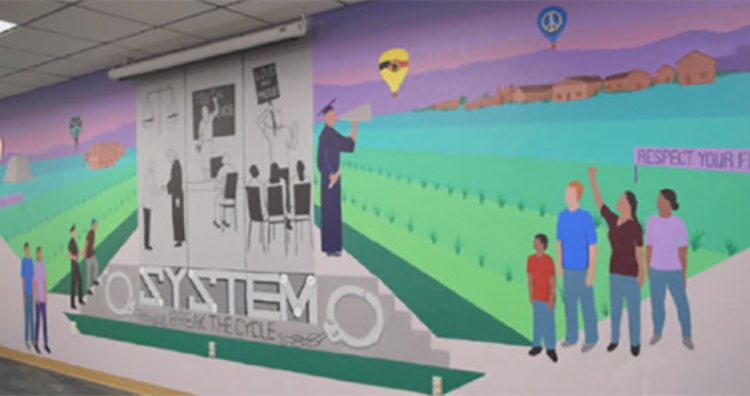On paper, Meghan Harrah and Albino Garcia had a shared goal: to reduce racial and ethnic disparities in the juvenile justice system. They also had a shared title: co-chair of the working group within JDAI (Juvenile Detention Alternatives Initiative) in Bernalillo County, New Mexico. But their different perspectives and unaddressed pain and anger, which stemmed from decades of racial and ethnic tensions, threatened to undermine this work.
Today, Harrah and Garcia are not just professional partners — they’re friends. They made a conscious effort to address hidden fissures caused by structural racism, and their story illustrates both the challenges and opportunities JDAI partners face when working with their counterparts in the community to improve racial and ethnic equity.

Garcia is executive director of La Plazita Institute in Albuquerque, a nonprofit that engages youth, elders and communities through a philosophy of “la cultura cura,” or “culture heals.” Garcia and those he represented felt resentment and pain toward a juvenile justice system that they felt locked their kids up while disrespecting their culture and history.
Harrah, a juvenile probation supervisor for the New Mexico Children, Youth and Families Department, represented that system. She and her staff felt under attack — and a target of hate — by the local community.
When Garcia and Harrah became co-chairs of the reducing racial and ethnic disparities working group a few years ago, distrust and negative assumptions clouded their work. Cultural differences in body language and communication norms led to unintended insults. When words such as white privilege, internalized racial oppression and generational oppression were spoken, each side felt misunderstood by the other and each felt the other was calling them racist and not good for kids. At one point, the divide between the two leaders grew so wide that they flat-out refused to work together.
Ultimately, through external mediation, Garcia and Harrah talked through the assumptions that each had made and confronted their own personal feelings and biases. Equally important: The leaders acknowledged how they, their communities and their employees fit into the larger societal dynamic of structural racism.
Structural racism reinforces or perpetuates inequity among racial groups through public policies, institutional practices and cultural norms. It operates at the societal level and is not caused by individuals.
Garcia recalls a pivotal moment in his relationship with Harrah: “I saw tears come out of my enemy’s [Harrah’s] eyes — I thought, ‘There’s a human inside there. … At least they are making an effort.’”
Now, the leaders are taking steps to bridge the divide between their respective communities. The probation department has developed two trainings for managerial and line staff. The first engages community members to educate staff members about structural racism and internal bias. More than 100 employees working in probation and detention have attended the four-hour training.
Harrah says she and her probation officers are learning to engage in more of a dialogue with community members, creating a safe space for anger and sadness and recognizing and respecting cultural traditions. The second training digs into local data on decision points. It is intended to help probation and detention staff members examine how their decisions can influence racial disparities within the system.
At the program level, promising changes include the probation unit’s implementation of a “stress pass” to address racial and ethnic disparities in probation violations. There’s also a new family advocate group, which provides support and information about the system to families. And La Plazita is now the evening reporting center for the county — a move that has promoted culturally competent collaboration among the juvenile justice system, youth, families and community members.
Garcia is focused on helping his community stop fighting and start uniting: “I have decided to fight in a different way,” he says. “I am going to try to get a little army of healers, plucking allies from the system. [Harrah] is one now.”
The Annie E. Casey Foundation is devoted to developing a brighter future for millions of children at risk of poor educational, economic, social and health outcomes.
This post has been updated.

Meghan Harrah was my juvenile probation officer for about 3 years , back in 1990 . My last name is the same as her former adversary . While I cannot speak on their own personal differences nor instigating variables thereof , I can say she was an exemplary and highly influential mediator that I had the good fortune of crossing paths with .
I can assure anyone reading this at no time did I , nor my mom and dad , ever feel or sense any type of racial /biased/ differential treatment She was a consummate facilitator in attempting to steer me on the right path at every turn . I can also say — I drove her NUTS !
So Meghan , if you ever read this : Randy Westgate , Wasted Masa High —– I KNOW you remember me . Take care !
P.S. you would be proud to know I am an Electrician and thanks to you , I NEVER spent 1 day in a correctional facility post juvenile age .
Now there is a Great story for you folks …I am living proof that , as I gleaned from the article , who cares which side of the fence people stand , at LEAST they care and are trying , whatever that may be . She cared.
This seems like such a good idea, will have to take a look at it!
Well done! I wish we would have had more time to meet with her and the Kellogg group when we were at La Plazita. “Siempre hacia la luz.” (Always towards the light.)